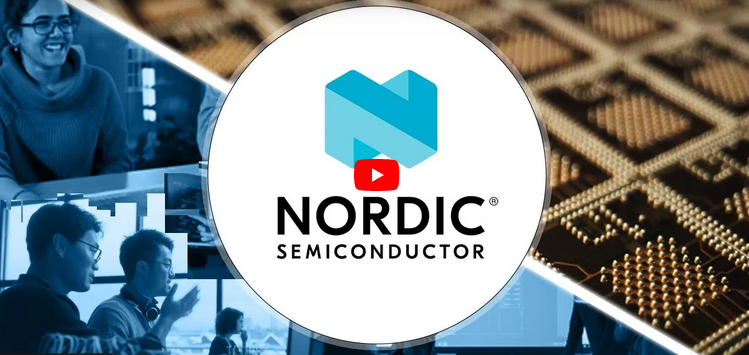Nordic Semiconductor has come a long way from its humble beginnings as a small, specialist supplier of ASIC design services in the Nordic region
Nordic Semiconductor announces that this year the company reached its 40th anniversary milestone since its founding in Trondheim 1983.
The history of Nordic Semiconductor could be described as one of two 20-year-old companies joined together, with the first laying the critical technical foundations for the second. The original Nordic Semiconductor, named Nordic VLSI, began life as a design house. Nordic VLSI sold consultancy services for mixed signal (analog and digital) application specific integrated circuits (ASICs) to individual customers in the Nordics, and later expanded into high performance data converters.
The second Nordic, rebranded to the current identity of Nordic Semiconductor in 2004, began in 2002 with the arrival of Nordic’s current CEO, Svenn-Tore Larsen. Larsen decided that the company would transform from a supplier of services to a supplier of wireless components. It was a keystone decision from which Nordic Semiconductor would never look back.
Wireless design is a challenging area of electronics engineering, often considered a technological art form. Over the company’s first two decades, Nordic has mastered the fusion of analog and digital signals, elevating its expertise and competence to extraordinary levels. “In 2004, this laid the foundation for us to make the strategic decision to lead in standard RF wireless components, says Svenn-Tore Larsen, Nordic’s CEO/President. “And in particular, standard wireless components engineered for ultra-low power consumption levels that could support battery-powered operation.”
Back in 2002 the whole world was ‘wired’. Since then, Nordic Semiconductor believes that, more than any other semiconductor company, it has done the heavy lifting to forever turn the world wireless. The company did this by first using license-free proprietary ISM (Industrial, Scientific, and Medical) frequency bands and later the 2.4 GHz band that would lay the foundations for modern-day Bluetooth® Low Energy (Bluetooth LE). In fact, Nordic effectively wrote the original engineering specification for Bluetooth LE in the early 2010s.
This connectivity revolution enabled the development of products that could operate wirelessly while running on battery power alone for extended periods of time (months or even years).
But it was the 2012 launch of Nordic’s nRF51 Series Systems-on-Chip (SoCs) that redefined the leading-edge of the Bluetooth LE market. This included using a powerful on-board Arm processor for the very first time, unprecedented amounts of embedded memory, and a unique software architecture that separated the Bluetooth RF protocol from application software to dramatically simplify coding. “The nRF51 Series literally sent Nordic’s competitors scrambling back to the drawing board when it came to how to design a Bluetooth LE chip,” recalls Larsen.
The nRF51 Series was later expanded to the nRF52, nRF53 and now latest nRF54 Series including the newly sampling nRF54H20 and nRF54L15 SoCs. Each of these Series in turn redefined the state-of-the-art in Bluetooth LE in areas such as power consumption, security, processing power, on-air performance, size, and integration. When launched in volume during 2024, the nRF54 Series will redefine what products and applications it is possible to build using Bluetooth LE.
Nordic Semiconductor today
Today Nordic Semiconductor’s mission is apparently to make low power wireless IoT connectivity accessible to all. Although the company intends to remain the world’s leading Bluetooth semiconductor chip and solutions provider, Nordic has become a complete end-to-end wireless connectivity solutions company offering products including Cellular IoT (NB-IoT and LTE-M), DECT NR+, low power Wi-Fi, Matter, Thread, ZigBee, Cloud and location services, and PMICs.
Related Articles

Anritsu, Sony Semiconductor validate industry first Non-Terrestrial Network (NTN) NB-IoT testcase
First NTN NB-IoT Protocol Conformance Tests for have been validated on the 5G NR Mobile Test Device Platform Anritsu Corporation has announced that the first NTN NB-IoT Protocol Conformance Tests for has been validated on the 5G NR Mobile Device Test Platform ME7834NR...

Ellisys Introduces Support for CCC Digital Key Technology
Protocol Updates Aid in Test, Validation, and Debug for Automotive and Consumer Electronics Developers and Test Labs Ellisys, a leading worldwide provider of Bluetooth®, Universal Serial Bus (USB), Ultra-Wideband, and Wi-Fi® protocol test and analysis solutions has...

Rohde & Schwarz 170 GHz power sensors ease use and traceability in the D-band
Rohde & Schwarz is launching the new R&S NRP170TWG(N) thermal power sensor for precise power level measurements in the D-band. The new R&S NRP170TWG(N) sensors from Rohde & Schwarz are used in general R&D for 6G mobile communications, novel sub-THz...
Stay Up to Date With The Latest News & Updates
Our Sponsors
Incisor.TV partners with leading organisations in the technology sector.
Follow Us
And stay up to date with our news! We are active across the key social media platforms – please do follow us!





0 Comments